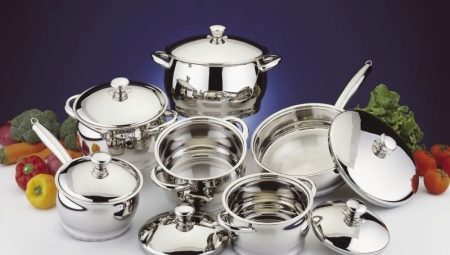Metal is actively used in the manufacture of kitchen utensils, tableware. One of the most sought after is stainless steel. It stands out for its positive features regarding quality and appearance, in light of which stainless steel utensils can be found in almost every kitchen.
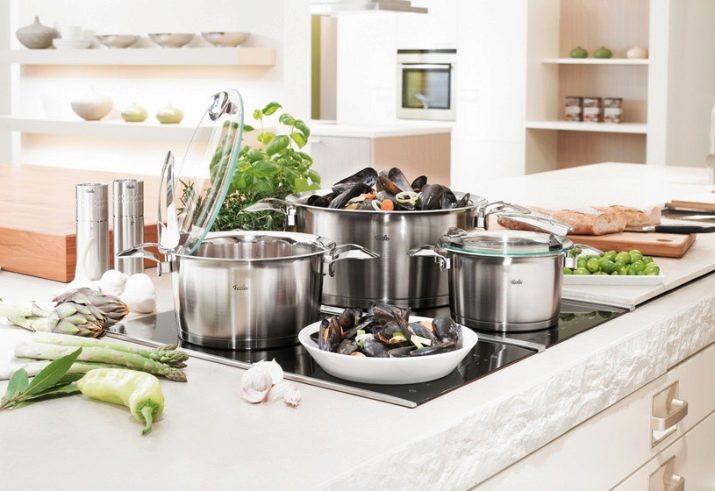
A bit of history
The stainless steel has been known to man since the days of Ancient Egypt and India, fragments of kitchen utensils made of this metal date back to 1000 BC. Today the scientist G. Brearly is called the inventor of stainless steel in the modern sense of the composition. Alloys, which today are used for the production of teapots, pots and other kitchen utensils, were patented at the end of the 19th century.
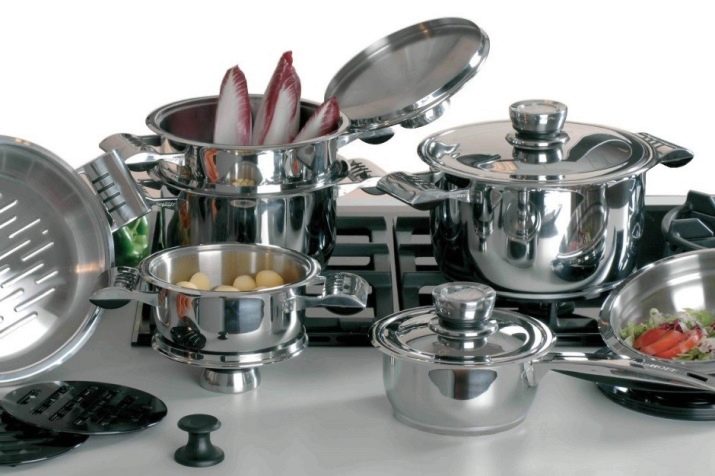
Stainless steel cookware reached its peak in demand only at the beginning of the 20th century. The monopolists among manufacturers at the very beginning were Asian companies that produced products at an affordable market value. Quality did not always live up to consumer expectations, so some brands left the market forever, but most manufacturers sell their metal products for cooking to this day. Among them, elite dishes, inexpensive products, budgetary capacities of the army and marching type stand out.
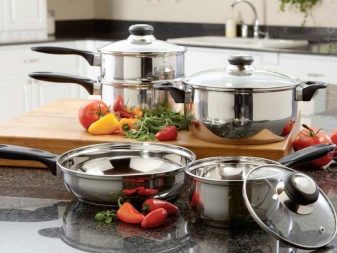
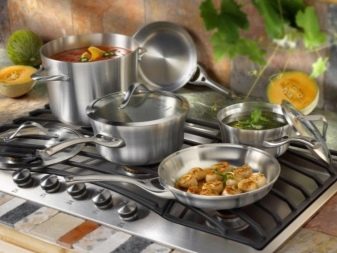
Not so long ago, stainless steel cookware made in Turkey appeared on the shelves of supermarkets, which has proved itself on the positive side with regard to design and quality.
The most famous manufacturer is the French company De BuyerHowever, previously she specialized in creating only elite steel cookware.Among European brands also stands out Italian brand Paderno. Domestic manufacturers entered the market not so long ago, however, the products of Russian companies today comply with established international quality standards, therefore they are successfully sold on the territory of the Russian Federation and abroad.
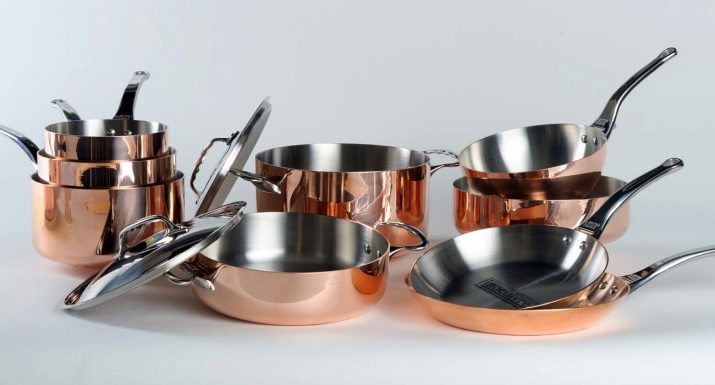
Advantages and disadvantages
Modern products for cooking stainless steel have positive and negative properties. The advantages of kitchen utensils made of stainless steel include a number of nuances.
- The main advantage of such dishes - both in a set and separately - is the external attractiveness. The presence of glass covers, which are most often sold complete with utensils, complements the charm of shiny surfaces.
- Metal stands out for its large operational resource, therefore, with proper operation of the cookware, it will last for 10 years or more.
- Steel is resistant to mechanical damage, unlike glass or ceramic, it will not crack if accidentally dropped.
- Hygiene is an important aspect for containers in which food will be prepared regularly. The metal structure is distinguished by the absence of pores, therefore, washing containers from various kinds of contaminants will be much easier in comparison with porous raw materials.
- Steel is compatible with any type of hob and hob, including induction models.
- Stainless steel is not harmful to human health, so you can safely cook any dishes from any products in it, in addition, you can store food in containers after cooking.
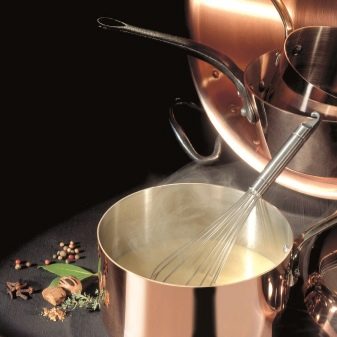
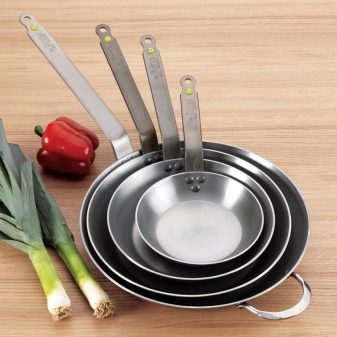
However, the metal is not without some drawbacks. The disadvantages of raw materials for the manufacture of kitchen utensils include several factors.
- Outside, traces of any touch will remain on the metal, which can adversely affect the appearance of the utensil.
- Due to the fact that the temperature inside the containers is distributed unevenly, there is a risk of food burning. But in pots and pans with a thick bottom, this happens extremely rarely.
- Steel is unstable to sudden temperature surges. In such situations, defects may appear on it.
- As a rule, good quality cookware from such an alloy stands out for its high cost.
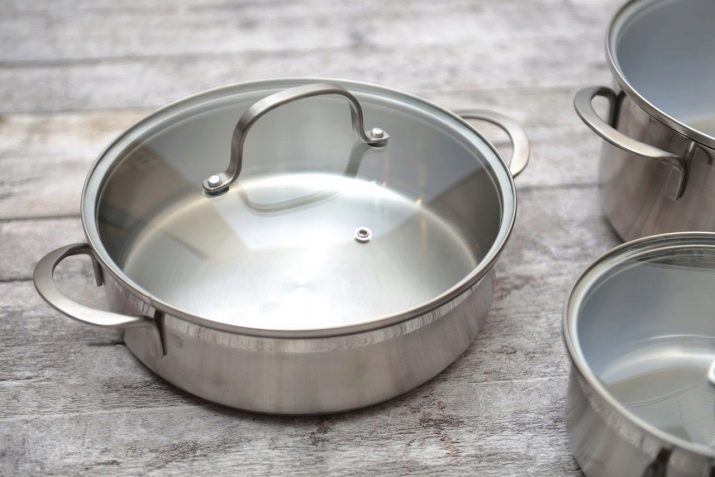
Varieties
Today, under the general name "stainless steel" hides several types of metal alloys that are applicable for the manufacture of containers for the kitchen. Most often, manufacturers use various alloyed alloys.
- 18/10 - A popular raw material that is used for the manufacture of professional and luxury dishes. Today, austenitic alloy is in demand by Russian and foreign manufacturers.
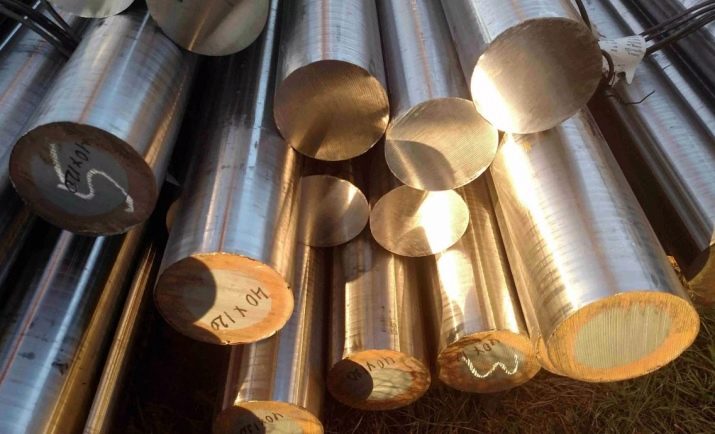
- 201 - a similar alloy is also called medical or surgical. But despite this definition, metal is most often used for the manufacture of tableware of a budget price category. This cheapening of steel products is due to a composition in which most of the nickel will be replaced by manganese.

You can meet this alloy in cutlery, as well as in other containers that are not designed for heat treatment of products on the stove, in the oven or in the microwave.
- 430 - ferritic alloy that does not have nickel in its composition. Such metal is in demand for the manufacture of a multi-layer “sandwich” at the bottom of kitchen containers.
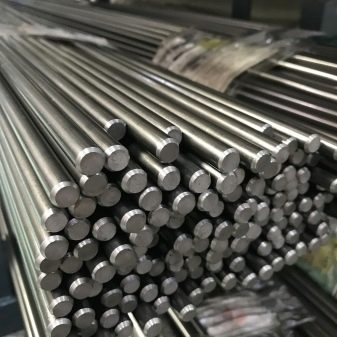
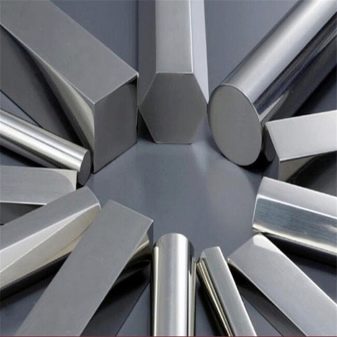
- 420 - a safe alloy that stands out among other varieties for its high strength indicators. Most often, forks, spoons, knives are made from this raw material.
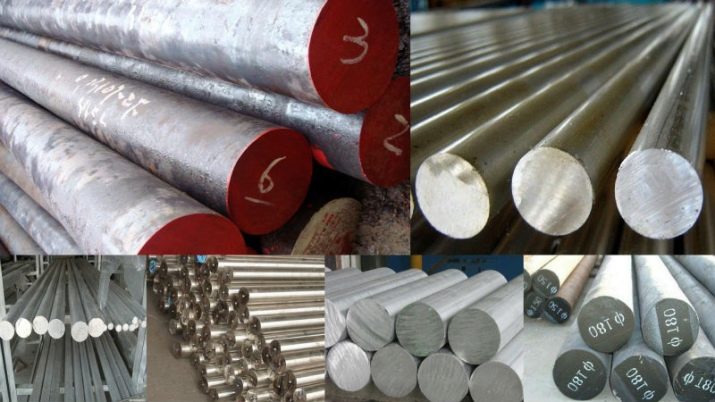
Classification of stainless steel dishes can also be made based on the method of its release. Raw materials from the budget category are produced by stamping, expensive utensils are made by casting.
Manufacturers Overview
Today, metal dishes are presented in supermarkets in a large variety, which allows each housewife or cook to choose the option that is most suitable for cost and characteristics.Among the manufacturers of kitchen steel utensils, it is necessary to distinguish several manufacturers.
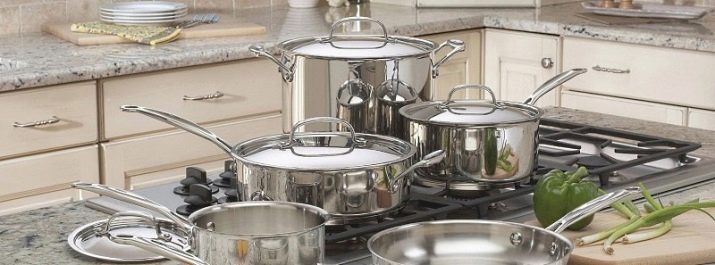
A bountiful harvest
Domestic brand, which has established itself on the positive side in the light of high quality dishes. It is especially appreciated by lovers of the canning process. The assortment includes pans and other dishes of different capacities with convenient lids that can withstand prolonged exposure to high temperatures.
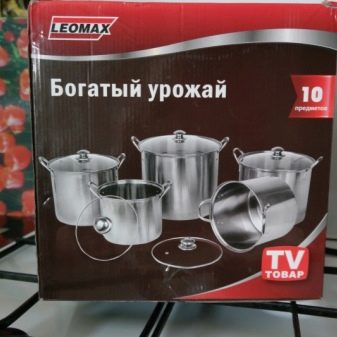
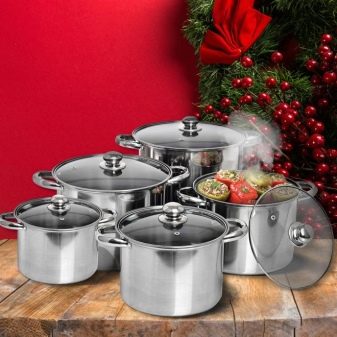
Fissman
Steel dishes from Germany, distinguished by high quality standards, corrosion-resistant properties. The products are durable, which allows them to operate for quite some time. In assortment is presented luxury product line, during the creation of which the manufacturer focused on the appearance, in addition, trade brand offers mid-range products.
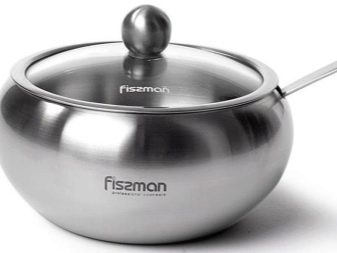
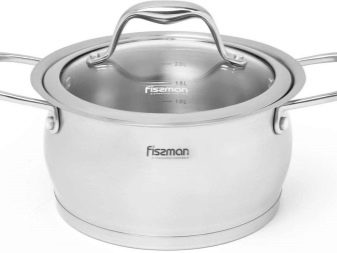
Bergoff
Steel utensils are presented in a wide variety. Cooking containers are made with a heat-accumulating bottom, which will allow food to heat up faster, in addition, in such a dish you can keep the dish longer, keeping it warm.
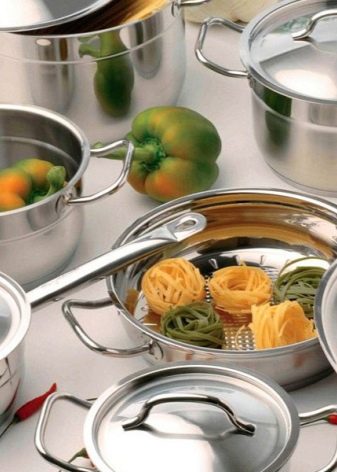
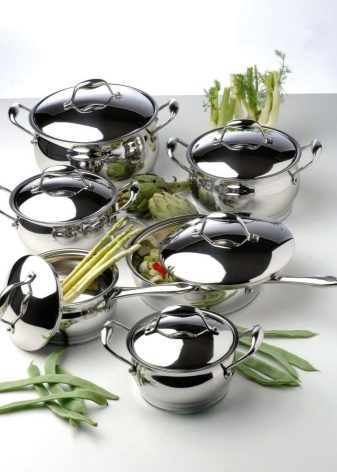
Tefal
A popular brand that offers consumers a wide selection of various carbon or galvanized steel products with a high level of quality. The products of this manufacturer are used by many professional chefs, cooking pots are equipped capsule bottom consisting of several layers of metal, which positively affects the cooking process.
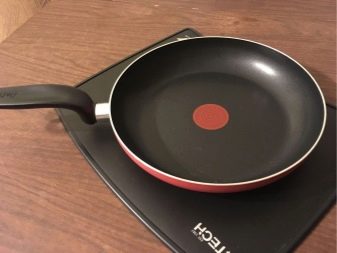
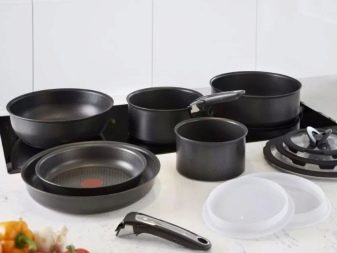
Kaiserhoff
Another German manufacturer who sells various kitchen utensils, including stainless steel. Products stand out for their attractive design, for ease of use, containers have a small scale on their walls, allowing you to adjust the volume of fluid inside. For the manufacture of dishes used high quality metal.
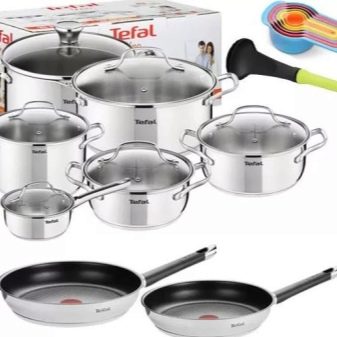
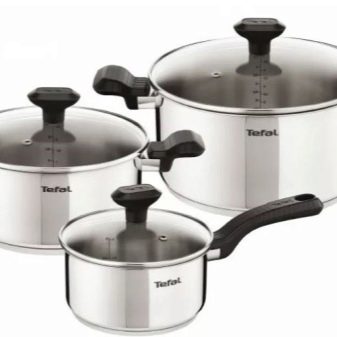
Calve
Cookware of this brand differs from the rest of the assortment in its external design, in addition, all steel containers used for cooking have a non-stick coating, which eliminates the appearance of residues of burnt food on the walls and bottom.


The containers are considered universal, therefore compatible with all types of cooking surfaces, in addition, they can be used in ovens.
How to choose?
The harm and benefits from the operation of steel utensils are determined primarily by its quality, so the choice of containers for cooking should be approached with all responsibility. In order not to make a mistake when buying stainless steel products, It is recommended to pay attention to several features of the products.
- It is best to initially buy universal utensils, which in the future can be used on any kind of stoves, in ovens, microwave ovens. Such products should contain 430 marking on the outside of the bottom. It is this version of the alloy that will allow the operation of containers in any version.
- High-quality dishes, if it involves a lid, should not contain gaps between its walls and the lid itself. This will ensure a uniform temperature distribution inside the dishes, in addition, excess liquid will not boil on the stove from the cracks.
- The optimum thickness of the bottom of steel dishes should be a value of 3 mm.
- For pans, the optimal wall thickness will be at least 0.5 mm, as for pans, for them this parameter starts with 1 mm.

Terms of use
For the safe operation of stainless steel cookware, there are several general recommendations, compliance with which will significantly extend their operational life.
- Do not place metal containers on fire.
- Using pots, pans, or other containers on gas burners, it is necessary to set the flame level under the container so that the flame does not go beyond it.
- It is not recommended to heat stainless steel cookware using too high temperatures. Therefore, dishes are best cooked over low heat.
- When mixing food, do not use metal tools. Spoons, skimmers and other products should be made of silicone or plastic. Use of wooden products is allowed.

Care Features
Stainless steel cookware will last longer if you take care of it carefully.
- In order to make it easier to take care of stainless steel containers, it is recommended to salt them during cooking only after boiling the liquid or, generally, at the end of cooking. Thus, it will be possible to avoid the appearance of scale on the walls.
- If the dishes will be operated with hard tap water, remove the white precipitate from the walls by boiling containers in water with the addition of table vinegar. It will also be possible to get rid of spots on the surface with the help of citric acid - it will need to clean places with neoplasms.
- Do not clean hot pans, bowls or pots. Without losses, it will be possible to wash the containers only after they have cooled, you can additionally soak them in warm water with or without chemistry.
- To clean dishes from scale, scale or plaque at home, it would be more correct to regularly care for stainless steel products, avoiding the use of abrasive substances and sponges with a hard surface.
- During the operation of dishes, it is better to take care of them manually, avoiding the use of a dishwasher. If the instructions for dishes contain a recommendation to wash by machine, before such a treatment, you should first soak the container for a while in a soap solution.
- After washing the container, it is best to wipe it dry additionally with a waffle towel. If you leave the steel products to dry naturally, leaks and stains may remain on the surface. To achieve shine on the walls, it is recommended to wipe with a point, non-circular movements.
- If the initial detergent composition for steel surfaces was not selected correctly, scratches may appear on the walls and bottom. In this case, it is necessary to replace the detergent composition with a more gentle and softer substance.
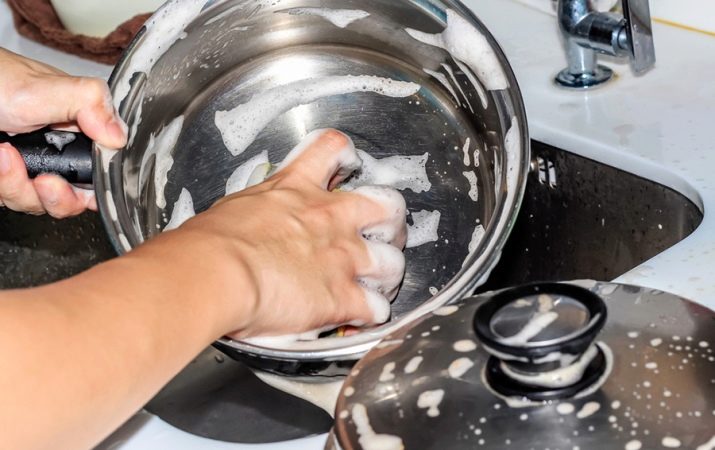
See how to choose stainless steel cookware in the next video.
